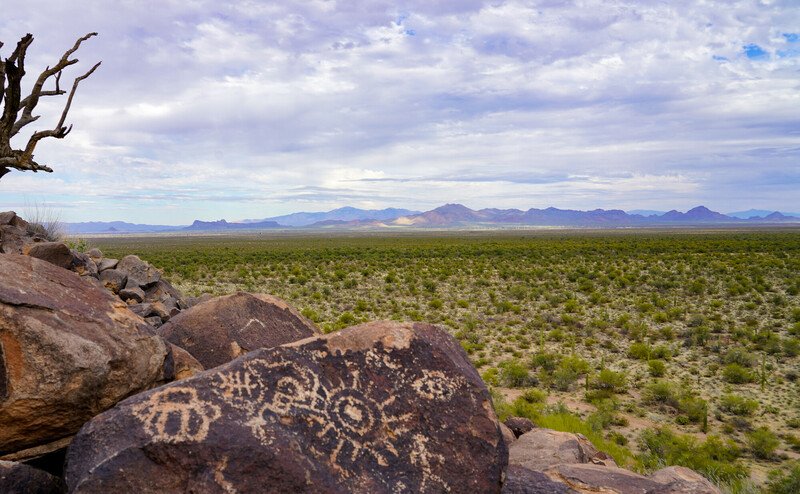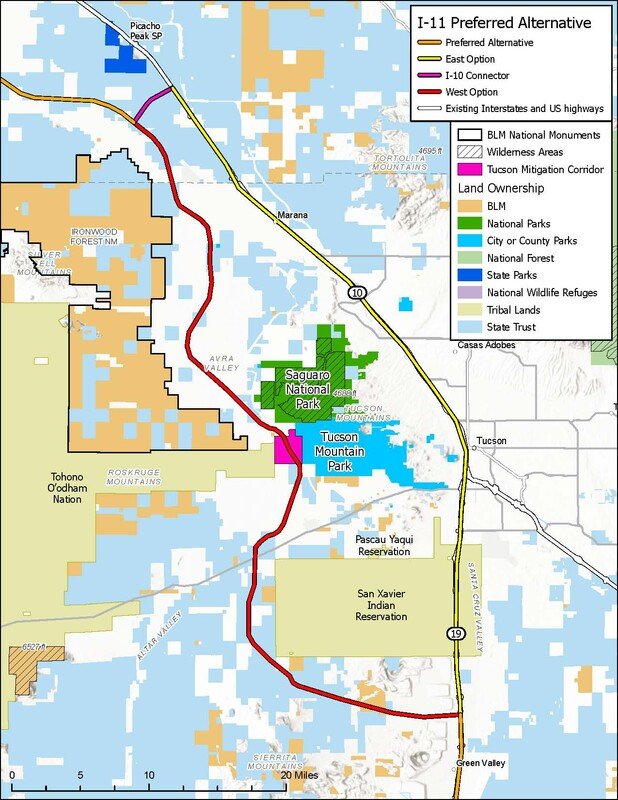For Immediate Release, April 21, 2022
|
Contact: |
Wendy Park, Center for Biological Diversity, (510) 844-7138, wpark@biologicaldiversity.org |
Lawsuit Challenges Federal OK of Arizona Freeway That Will Harm Climate, Wildlife, Public Lands
TUCSON, Ariz.— Conservation groups sued the Federal Highway Administration today to challenge its approval of Interstate 11, a proposed north-south highway in Arizona that would destroy pristine Sonoran Desert, harm threatened desert tortoises and other wildlife, and worsen air pollution.
Today’s lawsuit, filed in U.S. District Court in Tucson, says the agency failed to consider other transportation alternatives, such as rail, and sidestepped the required environmental review before approving the 280-mile-long highway between Nogales and Wickenburg.
“This is a road to climate catastrophe. It’s despicable to see state and federal officials playing into the hands of private developers and ignoring the climate emergency to approve this boondoggle,” said Wendy Park, a senior attorney at the Center for Biological Diversity. “Our precious desert wildlands should be off limits to this scale of destruction to give animals like the desert tortoise a fighting chance of surviving climate change. This unnecessary highway will mean more roadkill, fragmented wildlife populations, and more climate pollution.”
The agency approved the highway despite postponing an environmental review or deciding between two route options in Pima County, both of which would harm wildlife, public lands, and air quality and exacerbate the climate emergency. The lawsuit says this “approve now, study later” approach violated federal law.
“This is an egregious assault on 100 years of efforts by local, state and federal land agencies to protect important desert lands forever, for species to survive and move through the landscape,” said Carolyn Campbell with the Coalition for Sonoran Desert Protection. “There is overwhelming opposition by residents, tribal entities, public agencies and elected officials here in the Tucson area and we won’t stop until we’ve blocked this destructive and unneeded freeway that will harm our wildlands and wildlife.”
The West Option would route I-11 west of Tucson, through desert wildlands in rural Avra Valley and between Saguaro National Park and Ironwood National Monument. It would disturb hundreds of archaeological and cultural sites and spread invasive buffelgrass that would fuel more wildfires.
“We are appalled that FHWA continues to consider routing I-11 through pristine Sonoran Desert habitat that functions as an irreplaceable reservoir of biodiversity,” said David Robinson, Tucson Audubon’s conservation advocate. “Particularly outrageous is FHWA’s specious assertion that wilderness areas such as Saguaro National Park and Tucson Mountain Park, explicitly designed and managed for the protection of wildlife, are not covered by the Department of Transportation Act’s provisions for protecting wildlife refuges. The West Option route for I-11 would undo decades of work by Tucson Audubon and other conservation organizations, numerous government agencies and countless volunteers, all of whom have labored tirelessly to protect and restore southern Arizona’s imperiled ecosystems and astoundingly diverse wildlife.”
The West Option would spur significant, far-flung sprawl development in Avra Valley, harming public lands, groundwater and wildlife.
The National Park Service, U.S. Bureau of Land Management, U.S. Forest Service, U.S. Bureau of Reclamation, Arizona Game and Fish Department repeatedly raised concerns that the West Option would permanently and severely harm wildlife populations and public lands. Pima County, City of Tucson, Town of Sahuarita and the Tohono O’odham Nation urged federal officials to choose the East Option, which would use or expand existing roadways in and around Tucson, including Interstate 19 and Interstate 10, and cost $1.5 billion less than the West Option.
“The West Option for I-11 would clearly bisect the Avra Valley, thereby essentially preventing the normal migration of many animal species between the mountain ranges in the Ironwood Forest National Monument and the Tucson Mountains, Saguaro National Park and Tucson Mountain Park,” said Tom Hannagan with the Friends of Ironwood Forest. “Such major damage to wildlife connectivity would substantially impair the health and survival of these species, thereby ruining the natural ecology of these public lands.”
North of Tucson, regardless of whether the east or west option is selected, the new highway corridor would run alongside Sonoran Desert National Monument, threatening its wilderness and recreation. The route would sever critical wildlife corridors, threaten the Tucson shovel-nosed snake, whose habitat is rapidly shrinking, and increase wildfire risks by introducing non-native buffelgrass.
Background
In November 2021 the Federal Highway Administration approved the 280‐mile‐long corridor for Interstate 11, between the border town of Nogales and Wickenburg, Arizona, northwest of Phoenix. Proponents envision this project as part of an interstate route to Las Vegas that could eventually be expanded to cut across the entire western United States between Mexico and Canada.
The Arizona Department of Transportation will decide the route through Pima County. Initially the Federal Highway Administration recommended that the interstate go through undeveloped desert in Avra Valley, less than a half mile from Saguaro National Park, instead of co‐locating it with Interstate 19 and Interstate 10 in and around Tucson.
Federal agencies, local governments and elected officials have objected to the West Option. They include the city of Tucson, city of Sahuarita, Pima County Board of Supervisors, U.S. Rep. Raul Grijalva (D-Ariz.), the U.S. Bureau of Reclamation and the National Park Service.
Their concerns include increased suburban sprawl, groundwater contamination, and degrading the wilderness, wildlife habitat and recreational values of Saguaro National Park West, Tucson Mountain Park and Ironwood Forest National Monument.
They’re also concerned that the interstate would lead to development of conservation lands set aside to mitigate the impacts of other projects, including the Bureau of Reclamation's Tucson Mitigation Corridor, and lands protected under Pima County’s Sonoran Desert Conservation Plan.


The Center for Biological Diversity is a national, nonprofit conservation organization with more than 1.7 million members and online activists dedicated to the protection of endangered species and wild places.
The Coalition for Sonoran Desert Protection is a nonprofit community organization. The Coalition’s mission is to protect the biodiversity of the Sonoran Desert in southern Arizona through science-based advocacy, education and collaboration.
Founded in 1949, Tucson Audubon Society is southern Arizona’s leading non-profit inspiring, educating, and leading people to enjoy and protect birds, other wildlife, and their habitats, through recreation, education, conservation, and restoration of the environment upon which we all depend.
The Friends of Ironwood Forest is a volunteer organization dedicated to the protection and preservation of the Ironwood Forest National Monument. FIF sponsors volunteer programs that benefit the Monument, assists with studies of scientific interest at the Monument, and advocates for its permanent protection.

